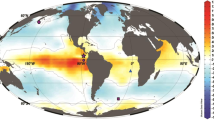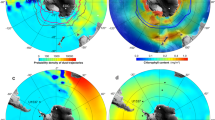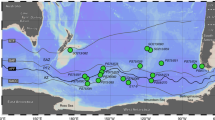Abstract
The eastern equatorial Pacific Ocean plays a crucial role in global climate, as it is a substantial source of CO2 to the atmosphere and accounts for a significant portion of global new export productivity. Here we present a 100,000-year sediment core from the eastern equatorial Pacific, and reconstruct dust flux, export productivity and bottom-water oxygenation using excess-230Th-derived fluxes of 232Th and barium, and authigenic uranium concentrations, respectively. We find that during the last glacial period (71,000 to 41,000 years ago), increased delivery of dust to the eastern equatorial Pacific was coeval with North Atlantic Heinrich stadial events. Millennial-scale pulses of increased dust flux coincided with episodes of heightened biological productivity, suggesting that dissolution of dust released iron that promoted ocean fertilization. We also find that periods of low atmospheric CO2 concentrations were associated with suboxic conditions and increased storage of respired carbon in the deep eastern equatorial Pacific. Increases in CO2 concentrations during the deglaciation are coincident with increases in deep Pacific and Southern Ocean water oxygenation levels. We suggest that deep-ocean ventilation was a primary control on CO2 outgassing in this region, with superimposed pulses of high productivity providing a negative feedback.
This is a preview of subscription content, access via your institution
Access options
Access Nature and 54 other Nature Portfolio journals
Get Nature+, our best-value online-access subscription
$29.99 / 30 days
cancel any time
Subscribe to this journal
Receive 12 print issues and online access
$259.00 per year
only $21.58 per issue
Buy this article
- Purchase on Springer Link
- Instant access to full article PDF
Prices may be subject to local taxes which are calculated during checkout




Similar content being viewed by others
References
Meyers, S. R. Production and preservation of organic matter: the significance of iron. Paleoceanography 22, 1–16 (2007).
Martin, J. H. Glacial-interglacial CO2 change: the iron hypothesis. Paleoceanography 5, 1–13 (1990).
Pennington, J. T. et al. Primary production in the eastern tropical Pacific: a review. Prog. Oceanogr. 69, 285–317 (2006).
Ziegler, M., Diz, P., Hall, I. R. & Zahn, R. Millennial-scale changes in atmospheric CO2 levels linked to the Southern Ocean carbon isotope gradient and dust flux. Nat. Geosci. 6, 457–461 (2013).
Anderson, R. F., Fleisher, M. Q. & Lao, Y. Glacial–interglacial variability in the delivery of dust to the central equatorial Pacific Ocean. Earth Planet. Sci. Lett. 242, 406–414 (2006).
Winckler, G., Anderson, R. F., Fleisher, M. Q., McGee, D. & Mahowald, N. Covariant glacial-interglacial dust fluxes in the equatorial Pacific and Antarctica. Science 320, 93–96 (2008).
Murray, R. W., Leinen, M. & Knowlton, C. W. Links between iron input and opal deposition in the Pleistocene equatorial Pacific Ocean. Nat. Geosci. 5, 270–274 (2012).
Costa, K. M. et al. No iron fertilization in the equatorial Pacific Ocean during the last ice age. Nature 529, 519–522 (2016).
Winckler, G., Anderson, R. F., Jaccard, S. L. & Marcantonio, F. Ocean dynamics, not dust, have controlled equatorial Pacific productivity over the past 500,000 years. Proc. Natl Acad. Sci. USA 113, 6119–6124 (2016).
Dubois, N. et al. Millennial-scale variations in hydrography and biogeochemistry in the Eastern Equatorial Pacific over the last 100 kyr. Quat. Sci. Rev. 30, 210–223 (2011).
Kienast, M. et al. Eastern Pacific cooling and Atlantic overturning circulation during the last deglaciation. Nature 443, 846–849 (2006).
Kienast, S. S. et al. Near collapse of the meridional SST gradient in the eastern equatorial Pacific during Heinrich Stadial 1. Paleoceanography 28, 663–674 (2013).
Rose, W. I., Conway, F. M., Pullinger, C. R., Deino, A. & McIntosh, W. C. An improved age framework for late Quaternary silicic eruptions in northern Central America. Bull. Volcanol. 61, 106–120 (1999).
McGee, D. et al. Tracking eolian dust with helium and thorium: impacts of grain size and provenance. Geochim. Cosmochim. Acta 175, 47–67 (2016).
Albani, S. et al. Paleodust variability since the Last Glacial Maximum and implications for iron inputs to the ocean. Geophys. Res. Lett. 43, 3944–3954 (2016).
Mahowald, N. et al. Dust sources and deposition during the last glacial maximum and current climate: a comparison of model results with paleodata from ice cores and marine sediments. J. Geophys. Res. 104, 15895–15916 (1999).
Dymond, J., Suess, E. & Lyle, M. Barium in deep-sea sediment: a geochemical proxy for paleoproductivity. Paleoceanography 7, 163–181 (1992).
Paytan, A., Kastner, M. & Chavez, F. P. Glacial to interglacial fluctuations in productivity in the equatorial Pacific as indicated by marine barite. Science 274, 1355–1357 (1996).
Francois, R., Honjo, S., Manganini, S. J. & Ravizza, G. E. Biogenic barium fluxes to the deep sea: implications for paleoproductivity reconstruction. Glob. Biogeochem. Cycles 9, 289–303 (1995).
Pena, L. D., Cacho, I., Ferretti, P. & Hall, M. A. El Niño–Southern Oscillation-like variability during glacial terminations and interlatitudinal teleconnections. Paleoceanography 23, 1–8 (2008).
deMenocal, P. B. et al. Abrupt onset and termination of the African Humid Period: rapid climate responses to gradual insolation forcing. Quat. Sci. Rev. 19, 347–361 (2000).
McManus, J. F., Francois, R., Gherardi, J. M., Keigwin, L. D. & Brown-Leger, S. Collapse and rapid resumption of Atlantic meridional circulation linked to deglacial climate changes. Nature 428, 834–837 (2004).
Wang, Y. J. et al. A high-resolution absolute-dated late Pleistocene monsoon record from Hulu Cave, China. Science 294, 2345–2348 (2001).
Burns, S. J., Fleitmann, D., Matter, A., Kramers, J. & Al-Subbary, A. A. Indian Ocean climate and an absolute chronology over Dansgaard/Oeschger events 9 to 13. Science 301, 1365–1367 (2003).
Peterson, L. C., Haug, G. H., Hughen, K. A. & Röhl, U. Rapid changes in the hydrologic cycle of the tropical Atlantic during the last glacial. Science 290, 1947–1951 (2000).
Donohoe, A., Marshall, J., Ferreira, D. & Mcgee, D. The relationship between ITCZ location and cross-equatorial atmospheric heat transport: from the seasonal cycle to the Last Glacial Maximum. J. Clim. 26, 3597–3618 (2013).
Kanner, L. C., Burns, S. J., Cheng, H. & Edwards, R. L. High-latitude forcing of the South American summer monsoon during the last glacial. Science 335, 570–573 (2012).
Wang, X. et al. Wet periods in northeastern Brazil over the past 210 kyr linked to distant climate anomalies. Nature 432, 740–743 (2004).
Takahashi, K. & Battisti, D. S. Processes controlling the mean tropical Pacific precipitation pattern. Part I: the Andes and the eastern Pacific ITCZ. J. Clim. 20, 3434–3451 (2007).
Bradtmiller, L. I., Anderson, R. F., Sachs, J. P. & Fleisher, M. Q. A deeper respired carbon pool in the glacial equatorial Pacific Ocean. Earth Planet. Sci. Lett. 299, 417–425 (2010).
Jaccard, S. L. et al. Subarctic Pacific evidence for a glacial deepening of the oceanic respired carbon pool. Earth Planet. Sci. Lett. 277, 156–165 (2009).
Jaccard, S. L., Galbraith, E. D., Martínez-García, A. & Anderson, R. F. Covariation of deep Southern Ocean oxygenation and atmospheric CO2 through the last ice age. Nature 530, 207–210 (2016).
Anderson, R. F. et al. Wind-driven upwelling in the Southern Ocean and the deglacial rise in atmospheric CO2 . Science 323, 1443–1448 (2009).
Denton, G. H. et al. The last glacial termination. Science 328, 1652–1656 (2010).
Martínez-Botí, M. A. et al. Boron isotope evidence for oceanic carbon dioxide leakage during the last deglaciation. Nature 518, 219–222 (2015).
Takahashi, T. et al. Climatological mean and decadal change in surface ocean pCO2, and net sea-air CO2 flux over the global oceans. Deep-Sea Res. II 56, 554–577 (2009).
Garcia, H. E. et al. World Ocean Atlas 2013, Volume 4: Dissolved Inorganic Nutrients (Phosphate, Nitrate, Silicate) (ed. Levitus, S.) Vol. 76 (A. Mishonov Technical Ed., NOAA Atlas NESDIS, 2014).
Johnsen, S. J. & North Greenland Ice Core Project members, High-resolution record of Northern Hemisphere climate extending into the last interglacial period. Nature 431, 147–151 (2004).
Lisiecki, L. E. & Raymo, M. E. A Pliocene–Pleistocene stack of 57 globally distributed benthic δ18O records. Paleoceanography 20, 1–17 (2005).
Rasmussen, T. L. & Thomsen, E. The role of the North Atlantic Drift in the millennial timescale glacial climate fluctuations. Palaeogeogr. Palaeoclimatol. Palaeoecol. 210, 101–116 (2004).
Bereiter, B et al. Mode change of millennial CO2 variability during the last glacial cycle associated with a bipolar marine carbon seesaw. Proc. Natl Acad. Sci. USA 109, 9755–9760 (2012).
Stuiver, M. & Reimer, P. J. Extended 14 C data base and revised CALIB 3.0 14 C age calibration program. Radiocarbon 35, 215–230 (1993).
Reimer, P. J. et al. IntCal13 and Marine13 radiocarbon age calibration curves 0–50,000 years cal BP . 55, 1869–1887 (2013).
Bacon, M. P. & Anderson, R. F. Distribution of thorium isotopes between dissolved and particulate forms in the deep sea. Geophys. Res. Lett. 87, 2045–2056 (1982).
Henderson, G. M. Seawater (234U/238U) during the last 800 thousand years. Earth Planet. Sci. Lett. 199, 97–110 (2002).
Henderson, G. M. & Anderson, R. F. The U-series toolbox for paleoceanography. Rev. Mineral. Geochem. 52, 493–531 (2003).
Suman, D. O. & Bacon, M. P. Variations in Holocene sedimentation in the North American Basin determined by 230Th measurements. Deep-Sea Res. 36, 869–878 (1989).
Singh, A. K., Marcantonio, F. & Lyle, M. Sediment focusing in the Panama Basin, eastern equatorial Pacific Ocean. Earth Planet. Sci. Lett. 309, 33–44 (2011).
Marcantonio, F., Lyle, M. & Ibrahim, R. Particle sorting during sediment redistribution processes and the effect on 230Th-normalized mass accumulation rates. Geophys. Res. Lett. 41, 5547–5554 (2014).
Taylor, S. R. & McLennan, S. M. The Continental Crust: Its Composition and Evolution (Blackwell Scientific, 1985).
McGee, D., Marcantonio, F. & Lynch-Stieglitz, J. Deglacial changes in dust flux in the eastern equatorial Pacific. Earth Planet. Sci. Lett. 257, 215–230 (2007).
Anderson, R. F. Concentration, vertical flux, and remineralization of particulate uranium in seawater. Geochim. Cosmochim. Acta 46, 1293–1299 (1982).
Griffith, E. M. & Paytan, A. Barite in the ocean—occurrence, geochemistry and palaeoceanographic applications. Sedimentology 59, 1817–1835 (2012).
Barnes, C. E. & Cochran, J. K. Uranium removal in oceanic sediments and the oceanic U balance. Earth Planet. Sci. Lett. 97, 94–101 (1990).
Colley, S., Thomson, J., Wilson, T. R. S. & Higgs, N. C. Post-depositional migration of elements during diagenesis in brown clay and turbidite sequences in the North East Atlantic. Geochim. Cosmochim. Acta 48, 1223–1235 (1984).
Zheng, Y., Anderson, R. F., van Geen, A. & Fleisher, M. Q. Remobilization of authigenic uranium in marine sediments by bioturbation. Geochim. Cosmochim. Acta 66, 1759–1772 (2002).
Thomson, J., Higgs, N.C., Croudace, I. W., Colley, S. & Hydes, D. J. Redox zonation of elements at an oxic/post-oxic boundary in deep-sea sediments. Geochim. Cosmochim. Acta 57, 579–595 (1993).
Acknowledgements
This research was funded by NSF grant OCE-0851056 to F.M. and M.L. Additional financial support was provided to F.M. by the Jane and R. Ken Williams Chair in Ocean Drilling Science, Technology, and Education. We thank L. Romero for her technical assistance in the laboratory. We thank A. Erhardt for constructive review.
Author information
Authors and Affiliations
Contributions
M.R.L. and F.M. designed the study. M.R.L. sampled the core, and performed the U–Th isotope analyses. M.R.L. and M.M.W. performed the Ba analyses. M.R.L. separated the foraminifera for oxygen-isotope analysis. M.R.L. and J.E.H. separated the foraminifera for radiocarbon analysis. All authors contributed to interpretation of the data. M.R.L. and F.M. wrote the manuscript, and all authors provided comments and revisions.
Corresponding author
Ethics declarations
Competing interests
The authors declare no competing financial interests.
Supplementary information
Supplementary Information
Supplementary Information (PDF 1039 kb)
Supplementary Information
Supplementary Information (XLSX 65 kb)
Rights and permissions
About this article
Cite this article
Loveley, M., Marcantonio, F., Wisler, M. et al. Millennial-scale iron fertilization of the eastern equatorial Pacific over the past 100,000 years. Nature Geosci 10, 760–764 (2017). https://doi.org/10.1038/ngeo3024
Received:
Accepted:
Published:
Issue Date:
DOI: https://doi.org/10.1038/ngeo3024
This article is cited by
-
Insights into the deglacial variability of phytoplankton community structure in the eastern equatorial Pacific Ocean using [231Pa/230Th]xs and opal-carbonate fluxes
Scientific Reports (2022)
-
Revisit of thorium-based dust fluxes and their implications for the iron fertilization hypothesis
Journal of Oceanography (2022)
-
Deep Equatorial Pacific Ocean Oxygenation and Atmospheric CO2 Over The Last Ice Age
Scientific Reports (2020)
-
No evidence for equatorial Pacific dust fertilization
Nature Geoscience (2019)
-
Marine nitrogen fixers mediate a low latitude pathway for atmospheric CO2 drawdown
Nature Communications (2019)



